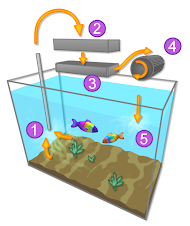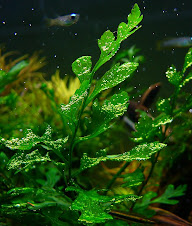From Wikipedia, the free encyclopedia
List of marine aquarium fish species
The following is a list of marine aquarium fish species commonly available in the aquarium trade. It is not a completely comprehensive list; certain rare specimens may sometimes be available commercially yet not be listed here.
Angelfish (Large)
These big beauties are luridly coloured and very interesting to watch, but not for the faint hearted aquarist. They need large aquariums and should not be kept in groups. Two angels might be kept in the same aquarium provided it is a large aquarium, they are properly acclimated as juveniles, and they are have very different colouring and body shape. However, because all Angelfish have essentially the same diet, mixing them is a feat that should be left to only advanced keepers. None are reef safe, and a potential owner should be aware that they need to have plenty of vegetable matter in their diet. They undergo major changes in colouration while maturing, and unless specified given descriptions are for adult specimens.
Angelfish (Dwarf)
Although Dwarf Angelfish are smaller and generally more manageable than their larger counterparts, they still have some specific care requirements. They are omnivores, but plenty of vegetable matter, preferably in the form of macroalgae, should be provided for their grazing pleasure. Their suitability for reef tanks is hotly debated, so add at your own risk. The only possible exception to this is the Flame Angelfish, which is generally considered safe. However, for obvious reasons it should not be put into tanks with expensive decorative macroalgae
Anthias
Although Anthias resemble damsels in shape and size, the two should never be confused. Where damsels are the goats of the Saltwater world, Anthias (also called "Fairy Basslets in) are finicky and many starve to death in captivity. In the wild, they eat zooplankton, and will not accept anything but in the aquarium. They also need to be fed nearly constantly, three times a day at least. The best way to ensure the health and longevity of an Anthias is to attach a refugium where you can grow copepods to "drip" into the display tank. Unlike many other saltwater aquarium inhabitants, they can be kept in groups.
Bass & Groupers
In this exceedingly large group of fish, few are considered proper aquarium inhabitants, for various reasons including diet and size. Be aware that Basses vary greatly from species to species, and do appropriate research before purchasing a specimen. Many unsuspecting hobbyists bring home cute little specimens of popular aquarium fish such as the Lyretail Grouper, only to realize several months later that they don't have the resources to care for a meter-long that may cost hundreds of dollars a month to feed.
Basslets & Assessors
Basslets and Assessors are small, long bodied fish strongly resembling Anthias. Their care requirements, however, are closer to those of damsels. They should be kept individually, and generally not with other fish of similar shape and colour. Feeding is easy: they will generally eat any meaty foods offered. Good water quality should be maintained at all times.
Batfish
Young Dusky BatfishBatfish are gorgeous and striking fish that are not common in aquaria for one major reason: they get huge. A two or three hundred gallon tank is needed for one, minimum, and larger is better. They start out as tiny, manageable-looking cuties, which often fools aquarists into purchasing them for their small aquariums. However they quickly grow to gargantuan proportions, and require large amounts of food as well as space, so beware. They are not reef safe and should be fed plenty of large meaty foods. Batfish change greatly as they grow, however the potential aquarist is most likely to see them in their juvenile form, so that is the description of the colouration here. They all have generally the same body shape: disk-like with tall dorsal and anal fins, similar to a Freshwater Angelfish.
Blennies
Blennies are popular aquarium fish, and for good reason. They are peaceful, colorful, and many are downright helpful. For example, the aptly named Lawnmower Blenny will keep your green algae well trimmed and presentable. With the exception of Fang Blennies, Blennies are totally reef safe- in fact a reef environment is really best for them because they can be shy and the intricate rockwork of a reef provides ample hiding spaces. They are omnivores and should be fed a varied diet of frozen or live foods and plant matter. Blennies don't have teeth or functional jaw, so food must be big enough for them to swallow whole.
Blennies are often confused with Gobies, but there is an easy way to tell the difference. Gobies have two distinct dorsal fins, Blennies have a single dorsal fin that runs the length of their body. Also, Gobies' pelvic fins are fused to form a sucker, similar to Remoras.
Boxfish & Pufferfish
Members of the family Tetraodontidae, Boxfish, Puffers and their cousins Cowfishes and Porcupinefishes can be very personable and quirky pets, for the prepared.
They are not thought of as an ordinary aquarium tank mate, but are quickly gaining popularity. They do pose a hazard in the community tank however. They are capable of releasing a very powerful toxin which can kill other fish and in some cases, the boxfish itself. They generally only use it when threatened or dying, but can become disturbed easily with aggressive tank mates or overcrowded aquarium. Generally they are reef safe, though they will pick at invertebrates if not fed well enough.
Many people think puffed up Pufferfish, like in the picture, are cute, but an owner should never subject their pet to this as they are often unable to expel the air should they be out of the water. To prevent this, never remove a puffer from the water.
Butterflyfish
Butterflyfish, when properly cared for, can make beautiful and distinctive additions to fish only marine aquariums. Often large and usually not suited for those with smaller aquariums, nor those of the faint of heart. Nevertheless, when fed a varied diet and kept in pristine conditions, Butterflyfish will usually thrive. That is, if you choose the right species. With Butterflyfish, usually a fish is going to survive, or it's not. Many species simply cannot be kept in captivity, and potential keepers must take care to only purchase those species that have a fighting chance. Also, be very picky about which specimen you choose- any sign of mishandling should be taken as a red flag.
The following species are relatively hardy and an experienced aquarist should have no trouble with them, so long as they are diligent.
Cardinalfish
One of the few groups of shoaling fish commonly available to marine aquarists, Cardinalfish are nocturnal and tend to be quite shy. They require meaty foods and will often not take prepared foods such as flakes and tablets. For the best chance of success, keep a wide variety of frozen foods on hand. In the event of a hunger strike, they will almost always take adult brine shrimp. As far as other care requirements they are similar to damsels: not picky. So long as they are properly acclimated, they tolerate a wide range of parameters. Watch the ammonia/nitrite, as they are particularly sensitive to these chemicals
Chromis
Chromis are perhaps the ultimate reef fish. Generally peaceful, most species are easy to take care of and quite colorful. Like anthias, they will school, but in many cases this tendency disappears as they age. They are, nevertheless, at least ambivalent with their own species, as well as completely reef safe. Like Damsels and Anemonefish, their close cousins, Chromis are omnivores and will accept most foods offered. A flake staple is usually sufficient, but for best color and health supplement with frozen and live foods when possible.
Clownfish
Clownfish, more technically known as Anemonefish, are the classic aquarium fish. Both hardy and attractive, they are perhaps best known for their symbiotic relationship with Sea Anemones, a relative of coral. In the wild, Anemonefish are always found with a host, leading many potential keepers to believe that an anemone is necessary to keep them. Anemonefish are easy to keep, but their cnidarian counterparts are inordinately finicky and need high light levels, and luckily Anemonefish will thrive without them. Aquarists often find that Anemonefish will host in other things, from corals and Feather Duster Worms to powerheads and other equipment. Anemonefish care is identical to that of Damselfish, as they are actually very closely related.
Damsels
All Damselfish can be considered reef-safe, sometimes excluding larger, more aggressive Dascyllus varieties. Some Damselfish will host in anemones like clownfish. Most Damselfish are aggressive and difficult to catch once you put them in an aquarium.
Damselfish change gender as they grow larger and older. Small damselfish are ungendered. Eventually, they become males if no males prevent them from doing so. 1 or sometimes 2 males live with a female and guard over the eggs. Females are the largest fish and dominant over the males and juveniles. They will not allow other females into an area they have claimed as their territory without a fight. They may not allow new males or juveniles, either. Aggression increases with each change.
Dragonets
Dragonets are often mis-categorized as gobies or blennies by fish sellers. They are bottom-dwelling fish that constantly hunt tiny invertebrates for food. Most starve to death in a marine aquarium unless you provide a refugium or place for the invertebrates to reproduce safely without any fish being able to reach them.
Hawkfish
Attractive and relatively small, Hawkfish make excellent additions to fish only or FOWLR aquariums. With extreme caution taken, they could be kept in reef aquariums, but because of their propensity to eat small ornamental shrimps and other mobile invertabrates (usually leaving sessile invertabrates alone) they are not considered reef safe. Lacking a swim bladder, Hawkfish can often be found resting in crevices of rocks or among the branches of corals or gregonians. Hawkfish are easy to care for and not picky at all about water quality. A varied diet, including spirulina and small meaty foods like Mysis is recommended.
Seahorse
It takes a special aquarist to maintain these delicate beauties. A potential keeper must be dedicated and willing to throw artistic creativity to the winds- as what seahorses need isn't always beautiful. They require taller tanks, live/frozen food, and many hitching posts, as well as very peaceful tankmates. In fact, beginners would be well-advised not to mix seahorses with any other species until they have more experience.
Seahorses found in stores are generally Captive Bred, but occasionally one might find a Wild Caught specimen. WC Seahorses should only be purchased by Seahorse experts who are going to breed them, as they tend to be finicky and most are endangered in the wild.
One of the main upshots of Seahorses is that many species stay small and can (in fact, some should) be kept in smaller tanks, making them idea for aquarists who are pressed for space or money.
Seahorses are among the few popular marine aquarium species that can be temperate. Species vary in their temperature requirement, so here an extra category has been added.
TR=Tropical ST=Sub-Tropical TM=Temperate
Tangs
Tangs generally feed on algae, though there are a few carnivorous species. Most tangs will not tolerate other fish the same color and/or shape as them. They have a spine on their tails that can cut open other fish and unprotected hands. All tangs should be given plenty of swimming room; try to have at least a 4' tank. Contrary to popular belief they will tolerate smaller (4' to 5') tanks just fine but tend to live better in larger tanks, over 5'.
[edit] Tilefish
Though often categorized as Gobies, Tilefish are a separate species.
Triggerfish
While they are generally considered monsters that will chomp invertebrates, many will actually make great reef fish.
Wrasse
Some wrasse species are aggressive towards small fish and invertebrates.














No comments:
Post a Comment